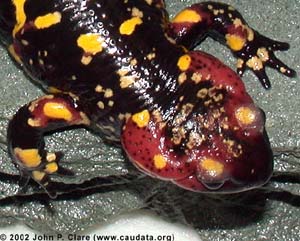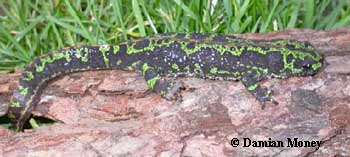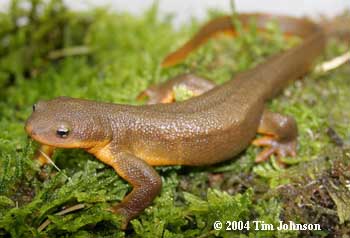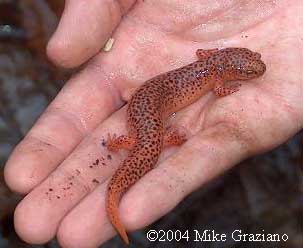Newt Toxins
By Wes von Papineau
Being small, soft, and slow-moving, newts appear to be relatively defenseless when it comes to fending off hungry predators. First and foremost, a lot of newts rely on green, black or brown colours along their back to blend into the environment, escaping the notice of potential predators. Some however, are marked with bright warning colors to indicate that they are toxic and are not desirable prey.
In this regard, newts do have an impressive, if varying in effectiveness, passive self defense mechanism. Like other amphibians, their moist skin is protected by mucosal secretions which serve first and foremost to keep water in and diseases out. However, the newts are also protected by parotoid or granular glands that produce toxic secretions, a protective covering that results in the newt becoming unpalatable or actually lethal to most predators.

Some salamanders, such as this Salamandra salamandra gallaica,
have prominent parotoid glands (just behind the eyes) from which they can eject toxin.
When approached by a predator on land, newts will position themselves in such a way as to place the most toxin-rich parts of their body closest to the predator. When some newts are stressed, they adopt the "unken position": an arched body, head tipped downward with closed eyes, and a tail wrapped or moving along the side of the body. Defensive postures are concurrent with the increased and often obvious production of more skin secretions. Some newts and salamanders actually have sharp ribs that protrude through their skin to further increase their ability to get toxin into the predator's body.

Some newts, such as this Triturus marmoratus,
can release toxin from glands in the skin. The small white spots
on this newt are toxic secretions.
But just how powerful are these newt toxins? Newt toxins range in severity of effect: approximately 25,000 mice (or one male university student) could be killed by the skin of the average adult Taricha granulosa. On the other extreme are the European Triturus species, all with very mild toxins.
There have been more that 200 "toxins" discovered among the amphibians (frogs and toads included) explored by scientists. However, for the purpose of this modest discussion we'll discuss the "tarichatoxin" or "tetrodotoxin" found in North American newts and some Asian and European relatives. Wakely et al. (1966) determined that tetrodotoxin-like substances were present in: Taricha torosa, T. rivularis, T. granulosa, Notophthalmus viridescens, Cynops pyrrhogaster, C. ensicauda, Triturus vulgaris, T. cristatus, T. alpestris and T. marmoratus. Taricha were the most toxic, and Triturus were the least toxic of those tested. Other references indicate that Paramesotriton species also have this toxin.
Tetrodotoxin, also known as TTX, is the most poisonous nonprotein substance known to scientists and similar to that found in pufferfish that occasionally poison Japanese gastronomists. This very potent non-protein neurotoxin (C11H17N3O8) acts by "blocking sodium channels of excitable membranes". In other words, it blocks the conduction of nerve signals to the muscles. Blood vessels relax, leading to a sudden drop in blood pressure and shock. Basically, the toxin blocks the signals from your brain that tell your heart to beat and lungs to breath.
The rough-skin newt (Taricha granulosa) is one of the most toxic animals known to science. One case involved a 29-year-old man who had been drinking heavily and swallowed a newt on a dare in Coos Bay, Oregon. Within 10 minutes, he complained of tingling in the lips. During the next two hours he complained of numbness and weakness and then experienced cardiopulmonary arrest. He died later during the day (despite hospital treatment). In another case, toxin from a Taricha entered a puncture wound on a scientist's index finger, and he suffered 30 minutes of numbness up the arm into the shoulder, and some accompanying nausea and light-headedness.

Taricha granulosa, the most toxic newt species.
When describing the effect on more natural predators, one reporter wrote: "Scientists have tested 30 potential predators of newts, from belted kingfishers to great blue herons to bullfrogs and fish, finding in every case that the newt killed them." Of related gastronomic note: folklore held that pigs in England could eat newts with impunity, while their French porcine cousins would die a horrible death from the same ingestion. On a social-historical note, it is said that some Native Americans of the Pacific Northwest used Taricha newts to poison their enemies.
The toxins range in severity of effect. Using de Lisle's scale, and comparing a variety of sources either using the same experiment ... or doing a rough comparative assessment, the following "ranking" of toxicity occurred (based on the amount of toxin within the species):
- Roughskin Newt (Taricha granulosa) (USA) - 25,000 mice killed
- California Newt- Male (Taricha torosa); Crocodile or Emperor Newt (Tylototriton verrucosuss); Redbelly Newt (Taricha rivularis) - 7,500
- Roughskin Newt - Canada (Taricha granulosa) (Canada); California Newt - female (Taricha torosa) - 2,500
- Japanese Firebelly Newt (Cynops pyrrhogaster); Hong Kong Warty Newt (Paramesotriton hongkongensis); Eastern or Red-spotted Eft (Notophthalmus viridescens) <2,500
- Eastern or Red-spotted Newt (Notophthalmus viridescens) 250
- Anderson's Newt (Echinotriton andersoni); Chinese Warty Newt (Paramesotriton chinensis); Guizhou Warty Newt (Paramesotriton caudopunctatus); Tsitou Newt (Pachytriton brevipes); and Spanish Ribbed Newt (Pleurodeles waltl) have secretions, but of unknown (to me) composition and strength.
- Least Toxic - Smooth Newt (Triturus vulgaris); Crested Newt (T. cristatus); Alpine Newt (T. alpestris); and Marbled Newt (T. marmoratus).
Furthermore, the toxicity of any individual newt is affected by a variety of factors:
- Age - For example, the Notophthalmus viridescens eft is ten times as potent as the adult. Of related note, Tetrodotoxin isolated from the eggs of Taricha is far more toxic than any other known substance from the skin of salamanders.
- Location - The Rough-skinned Newt (Taricha granulosa) on Vancouver Island, British Columbia, has low levels of TTX. Skin extracts from these newts are at least 1,000 times less toxic than those obtained from rough-skinned newts from the Willamette Valley, Oregon. Studies suggest they have lost most or all of their TTX toxicity); and
- Gender - For example, the skin of the male Taricha torosa was more than three times as toxic as the skin of the females.
The efficacy of the toxin may not necessarily decay with age either. One observer mentioned that "A sample of the poison had lost none of its potency when examined 11 months after storage".
The safety concerns of handling newts, whatever their species, should be apparent by now. However, a newt's toxin is passed to a predator (or careless human handler) only through the disgestive tract, a break in the skin, or via any mucous membrane such as the eyes. So, it is safe to handle newts as long as one washes hands thoroughly afterwards, and doesn't touch their eyes or mouth until after a thorough cleaning. It goes without saying that children must be supervised at all times when they're around newts ... whether as pets or in the wild.

Hands should be washed thoroughly after handling any salamander or newt.
In case of Newt Ingestion Poisoning, de Lisle recommends that "the first aid be forced vomiting" and that "humans should be administered 50 to 100 g of activated charcoal to help absorb the toxin. Supportive therapy should also be provided until the neurotoxin has dissipated." First aid will have to be administered rather quickly, particularly if the newt has been ingested by the family pet. The toxicity of a newt is so powerful that toads swallowing bypassing newts died in a horrible fashion: "Sometimes the newt crawled unharmed out of the gasping mouth of the deceased within minutes of being swallowed".
The lessons here are:
- Rinse your hands with cool water before handling any newt or salamander (for their protection) and wash with soap after handling (for your protection).
- Don't stress your newts.
- Don't place any newt in your mouth! (A blinding revelation of the obvious.)
However, as dangerous as they are, newts still retain a unique appeal for naturalist and hobbyist alike, a feeling best summed up by one who has studied Tarichas for a while: "They are one of my favorites," said Lynn Havsall, former director of the Camp Long Nature Center in Seattle. "So beautiful. You just don't want to kiss them."
References
1. Brodie ED, et al. 1974 "Toxicity of the Urodele Amphibians Taricha, Notophthalmus, Cynops and Paramesotriton." Copeia #2, p. 506.
2. Brodie ED, et al. "Antipredator Adaptions of Asian Salamanders". Herpetologica Vol 40, pp.59-60.
3. de Lisle H. "Poisoning from the Rough Skinned Newt" Herpetology, Vol 13, p.7.
4. Duellman WE & Trueb L. 1986. Biology of Amphibians. McGraw-Hill Publishing Co., Toronto, p. 257.
5. Frank N & Ramus E. 1995. A Complete Guide to Scientific & Common Names of Reptiles & Amphibians of the World. NG Pub, Inc. Pottsville USA.
6. Griffiths RA. 1996. Newts & Salamanders of Europe. Academic Press, Ltd, London, p.32.
7. Leonard WP, et al. 1993. Amphibians of Washington & Oregon. Seattle Audubon Society, p. 56.
8. Stebbins RC & Cohen NW. 1995. A Natural History of Amphibians. Princeton University Press, NJ. pp. 114-115.
9. Wakely JF, et al. 1966. "The occurrence of tetrodotoxin (tarichatoxin) in amphibia and the distribution of the toxin in the organs of newts (taricha)". Toxicon, Vol 3, pp. 195-203.
© 2003 Wes von Papineau
